Forgotten Indian Artists Under British Rule
When Europeans first established a foothold in India, they were keen on acquiring the subcontinent's wealth and understanding its rich culture. Once they secured dominance, a remarkable blend emerged between British academic drawing and Mughal, as well as Indic, artistic traditions. Historian William Dalrymple explores this fusion in hybrid paintings that capture life and nature. The Wallace Collection in London hosted an exhibition titled Forgotten Masters: Indian Painting for the East India Company, focusing on works from 1770 to 1840. It is the first British exhibition dedicated to Indian artists, which was commissioned by British patrons and linked to the East India Company. These artists fall under the category known as 'Company Painting', as defined by art historians and curators.
Yellapah of Vellore
Yellapah of Vellore painting name: Self Portrait (image source: Hyperallergic)
He was an exceptional portrait painter, known for his unique style. A South Indian artist from the 19th century, he was part of the 'picture moochie' caste, a group of leather workers to which many Tanjore school artists belonged. Notably, he painted a self-portrait where, unlike Western artists who are often depicted sitting at a table or standing at an easel, he is seated cross-legged on the floor, with his tools spread around him. Although he worked for the British, he never painted Europeans, perhaps as a subtle act of resistance.
Ghulam Ali Khan
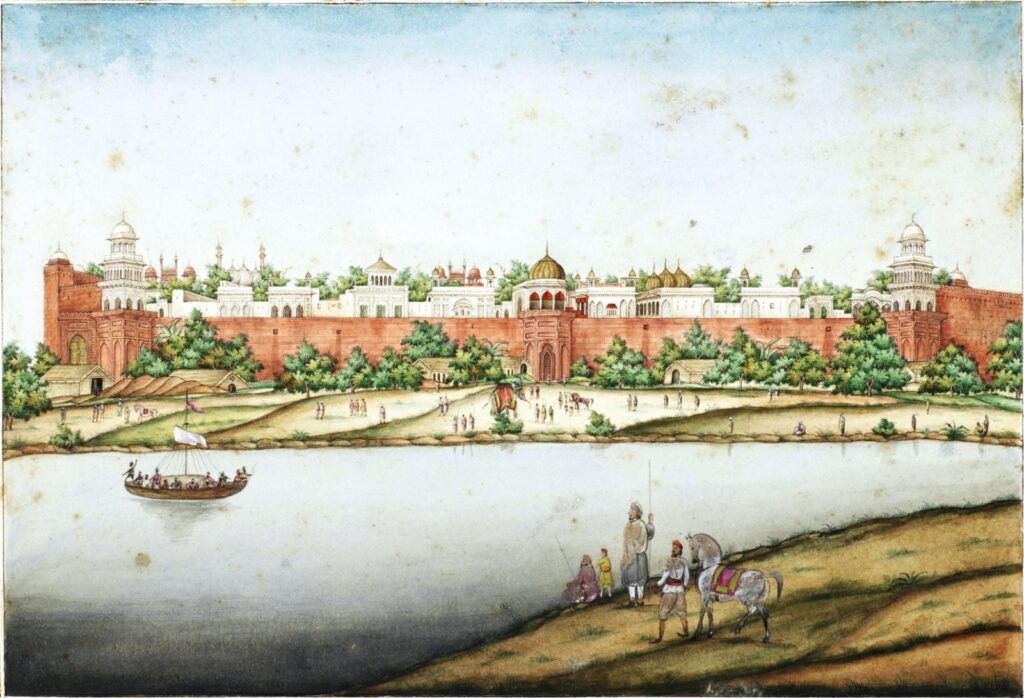
Ghulam Ali Khan painting name: view of the Red Fort (image source: Wikimedia Commons)
He is the last royal Mughal painter from Delhi and was closely associated with the East India Company. He adopted the Company style to cater to his British patrons, such as William Fraser and James Skinner. Fraser, deeply influenced by Indian culture, commissioned local artists to create a collection of paintings known today as the Fraser Album. Ghulam Ali Khan contributed significantly to this collection with his detailed watercolour paintings, often depicting village life, soldiers, Indian nobles, and rural scenes. His works, typically painted on gold paper with black margins, showcase a high level of detail and mastery of perspective. In addition to his figurative work, Khan painted at least 31 buildings and monuments around Delhi, further cementing his legacy as a skilled and versatile artist.
Mazhar Ali Khan
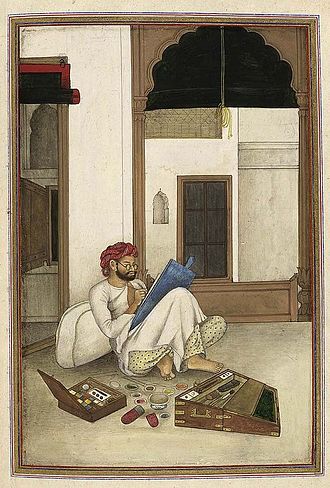
Mazhar Ali Khan - "self-portrait" (image option: Wikimedia)
He was a renowned 19th-century Indian painter from Delhi during the late Mughal era. His work was rooted in the traditional style of post-Mughal art, particularly influenced by Company painting. However, his art also reflects clear influences from Western art, resulting in a unique fusion of styles. One of his most famous works is a self-portrait, where the artist is depicted leaning against a wall while painting. Over his career, he created 100 notable paintings, many of which were featured in a prominent book. Particularly in the famous book "The Delhi Book", commissioned by Sir Thomas Metcalfe, a British civil servant.
Shaikh Zain ud-Din
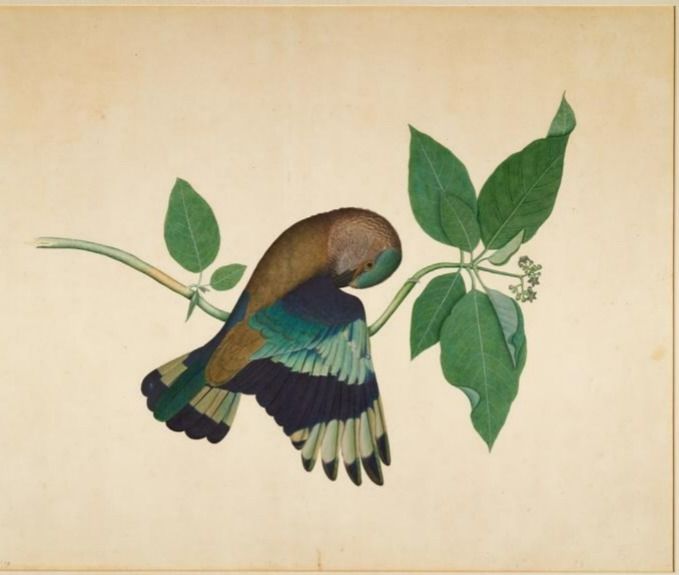
Shaikh Zain ud-Din, Painting name: Indian Roller on Sandalwood Branch (image option: ArtsMia)
Patna-based Muslim artist initially trained as a Mughal miniature painter but gained recognition for his work commissioned by British colonialists Sir Elijah Impey and Lady Mary Impey. His most notable contributions were to Lady Mary's collection of flora and fauna, where he depicted a variety of birds, animals, and native plants. He was commissioned to create life-size paintings of birds in the flat style typical of Indian art. His works include pieces like the Indian Roller on a Sandalwood Branch and the Malabar Giant Squirrel, both painted in their natural habitats. His detailed portrayals demonstrate exceptional skill and ability to capture the essence of wildlife, solidifying his reputation as one of the finest artists of his time.
Bhawani Das
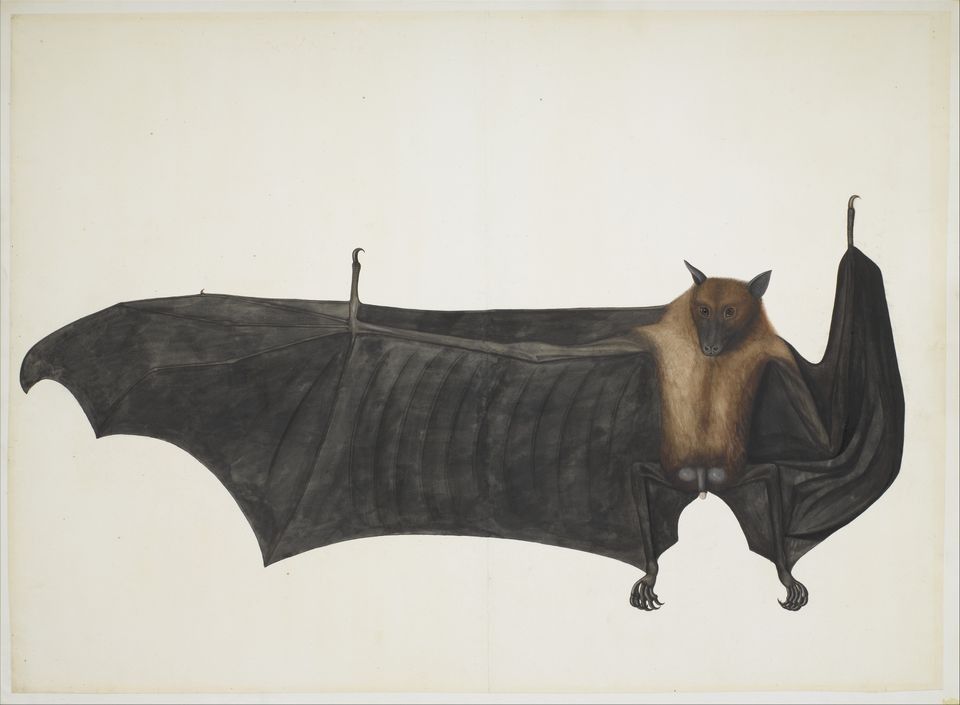
Bhawani Das painting name: Great Indian Fruit Bat (image source: Brown pundits)
With Shaikh Zain ud-Din Bengali artist Bhawani Das, contributed to the impressive collection of animal paintings commissioned by Lady Mary Impey. Bhawani Das, trained in Mughal-style portraiture, became renowned for her striking painting of the Great Indian Fruit Bat. In this work, she skillfully captured the bat's real personality, with meticulous attention to details like the winged veins. Her anatomical precision brought the bat to life, making it one of her most iconic pieces. Das also created other notable works, including "Hanging Fruit Bat" and detailed drawings of various fish, such as the "Puffer Fish" and "Mango Fish," all part of the 326 paintings in the Impey Album.
Manu Lall
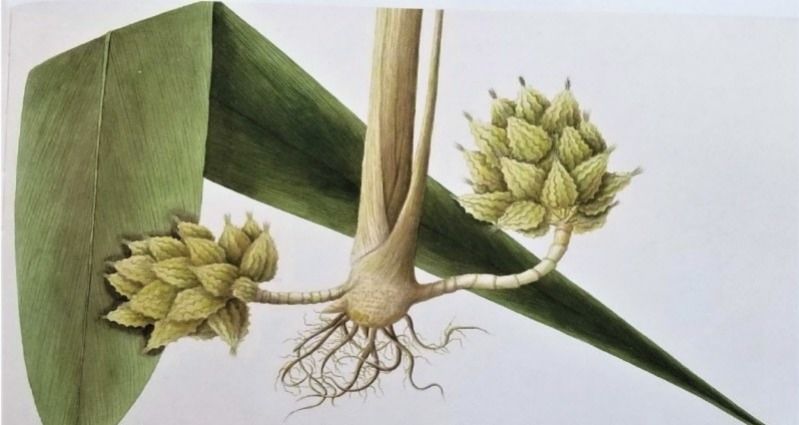
Manu Lall painting name: A Wild Ginger (image source: DAWN)
A relatively lesser-known artist made significant contributions to Indian botanical art, capturing plant groups with remarkable accuracy in his paintings. His works showcased intricate details of leaves, roots, and stems of various vegetables. Specialising in Indian botanical drawing, he worked in Calcutta and signed his pieces as the "painter from Azimabad," reflecting his identity as a Patna Kalam artist. Many of his drawings were made for civil servant Richard Parry, which he later presented at the East India House.
Sita Ram

Sita Ram Painting Rumi Darawaza (image source: BBC)
Renowned Indian artist, hailing from Bengal in the 19th century, was trained in the late Mughal school of Murshidabad. He is widely known for his association with the British East India Company, having transitioned from traditional Mughal patronage to working with British patrons in cities like Calcutta, as Mughal influence waned. In 1814, he embarked on his most significant project, a 15-month expedition with Lord Hastings, the Governor-General of India, documenting the journey from Calcutta to northern India. He produced 229 watercolours, capturing landscapes, buildings, and people along the way, including serene river scenes and historical monuments like the Rumi Darwaza in Lucknow. His works are also showcased in the British Library.
In conclusion,
During British colonial times, Indian artists made significant contributions to the East India Company, yet their recognition among Indian people remains largely forgotten. While their modern paintings beautifully showcased Indian culture, they never received the appreciation they deserved. Many British collectors took these artworks back with them, leaving us with the misconception that Indian art of that era was not highly valued. This piece is a small attempt to bring attention to these unsung artists, offering a glimpse into their extraordinary yet overlooked contributions.
To learn more about Indian art and artists, download the Rooftop app from the App Store or Google Play to stay updated on our upcoming art events and workshops. Stay tuned to rooftop blogs and follow us on @rooftop_app.
By Shrushti Patel